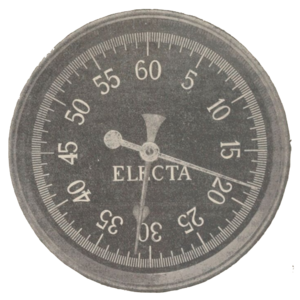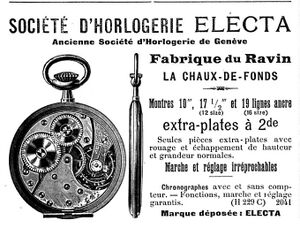Electa
Electa was a high-profile watch company in La Chaux-de-Fonds from 1901 through 1924. The firm was descended from Swiss-American businessman Prosper Nordmann's 1897 establishment of a factory in Geneva to supply Waltham Watch, which moved to La Chaux-de-Fonds in 1901. The bankrupt company was purchased by Gallet in 1907, established a new factory in 1913, and was bankrupt again in 1924. The Electa brand was taken over by Rotherham and Sons of London in 1926.
Prosper Nordmann
Prosper Nordmann was born in Hegenheim in the Alsace region close to Basel, Switzerland. He emigrated to the United States to pursue a watchmaking career. Nordmann pioneered the mechanized construction of complicated watches in New York in 1876, including repeaters and chronographs. Nordmann registered patents with other pioneering Swiss and American watchmakers, including Henry-Alfred Lugrin, Charles Morlet, and Charles Schlatter, as well as Albert Bonzon of Cuba.
From 1876 until 1890, all of the complicated watches sold by the Waltham Watch company were produced by Nordmann in New York.
In 1890, Nordmann moved back to Switzerland, establishing a watchmaking business at Rue Neuve-du-Temple 42 and Boulevard James-Fazy 6 in Geneva. He continued to specialize in complicated movements, and continued to work with Charles Morlet who also moved from New York to Geneva at this time.
Between April 9 and May 6, 1891, Nordmann created the Timing and Repeating Watch Company, a public limited company in Geneva. This firm was to handle production and export of chronograph and repeater movements produced in Geneva to American forms, and its creation was likely the reason Nordmann moved back to Switzerland: The Waltham Watch company found that it was cheaper to purchase complicated movements produced in Switzerland than to manufacture them in the United States. According to an 1892 article, this company used the "celebrated Lugrin Patent formerly controlled by the American Waltham Watch Co." Although the firm supplied many movements in Britain and America through the turn of the century, it was deleted from the registry due to non-use in December 1907.

Nordmann impressed the crowds at the 1896 Swiss National Exposition in Geneva with his simple movements, counter chronographs, counter rattrapantes, simple repeaters, and chronograph rattrapante watches, which he finished and regulated. Nordmann claimed that the roughing, finishing, and machining was entirely done by mechanical processes in his workshops using patented systems he designed. He also showed a chronographic clock precise to one-fifth of a second, for use at racetracks and velodromes with an electrical trigger for starting, stopping, and resetting the hands. Nordmann won a silver medal for this display. Among those focusing on Nordmann at the Geneva expo was Jacques David, head of technical operations at Longines, who noted that Nordmann was focused on split-seconds chronographs and repeaters "which are considered in the United States as very important because they were made fashionable by American factories in the simple watch." David was also impressed that Nordmann was able to produce his own assortiment.
Société d'Horlogerie de Genève
Confident in his work, Nordmann incorporated his company between May and December of 1896, raising 200,000 francs by selling shares. The firm, called the Société d'Horlogerie de Genève, was headquartered in Paris at Rue de Mulhouse 4 with a branch in Geneva to handle manufacturing at Rue de St-Jean 8. The Geneva factory was popularly referred to as the Usine de St-Jean and employed about fifty workers by 1896. Among the companies selling complicated watches (mainly chronographs) produced by Nordmann was Schwob Frères of La Chaux-de-Fonds (which would become Cyma in 1945). This company was more successful than Nordmann's export firm.
The Usine de St-Jean was also home to other watchmakers: Guye et Cie produced balance springs there starting in July of 1894. Emile Servet produced watch stems and tubes there in 1895, Alphonse Lecoq produced electrical dynamos, and a firm called Securitas produced security apparatus. After Nordmann's chronograph operation closed the factory was taken over by the FSR spring cartel, successor to Guye et Cie, which remained there until constructing a new factory nearby in 1913. The Useine de St-Jean was torn down and replaced by the current École de Saint-Jean in 1913.
By 1901 Nordmann had relocated to Paris, France. He continued his watchmaking work there, registering more patents. The Usine de St-Jean remains listed in Indicateur Davoine from 1894 through 1903.

On March 14, 1901, the Société d'Horlogerie de Genève relocated to La Chaux-de-Fonds. Prosper Nordmann was replaced as director by Jules Grumbach of La Chaux-de-Fonds, who shared management with Charles Perret. Under Grumbach the company took the brand name Electa, rising to some success before bankruptcy and acquisition by Gallet.
Electa Ravin
The former Société d'Horlogerie de Genève established a new factory at Rue du Ravin 17 in La Chaux-de-Fonds in 1901, while at the same time reorganizing as a company headquartered in that city and taking the name Société d'Horlogerie Electa. The firm was now managed by Jules Grumbach, originally of Morteau, France, who was well-known in the local watchmaking business.
Electa is a Latin word meaning "chosen" and the name refers to the anonymous "chosen lady" addressed by the Apostle John in his second letter in Freemason tradition. The Société d'Horlogerie de Genève registered the brand for watches March 8, 1900, and it became prominent when the company moved to La Chaux-de-Fonds the following year.
Electa and Gallet
- See Also: Gallet & Co
The Usine du Ravin in La Chaux-de-Fonds produced fine watches under the direction of Grumbach and manager Charles Perret for a few years, but was dissolved at its general meeting on December 31, 1906. It is likely that this occurred for financial reasons, since the firm was liquidated by Jules Grumbach, Gorges Bernheim (the secretary of the company), and Maurice Grumbach (of Paris) with a warning to creditors to file their claims. Ownership of the firm was immediately taken by Gallet, which quickly transferred the registration of the Electa and Aurea brands and renamed itself Gallet & Co, Fabrique d'Horlogerie Electa on January 14, 1907.
Gallet has often been claimed to have purchased the firm of Grumbach & Cie in 1855, but documentation of this claim is scarce. Indeed, the Grumbach family was long involved in watch manufacturing, with Alexandre Grumbach first appearing as a watch dealer in Sonvillier that same year. Léon Grumbach is listed as a watchmaker in Bienne from 1867 through 1903, and Alex and Florine Grumbach appear in La Chaux-de-Fonds at Rue du Parc 1 between 1869 and 1883 as watch merchant and regulator. There is no indication that the Gallet family owned or was involved in any of these firms.
The firm of Woog (Maurice) and Grumbach is listed in Indicateur Davoine between 1880 and 1898. The official survey of businesses in 1883 clarifies that this is Maurice Woog, originally from Buschwiller (Alsace) then Morteau, and Jules Grumbach of Bollwiller (Alsace) then Morteau, both of whom moved to Chaux-de-Fonds. The company's address at that time was Rue Léopold-Robert 9, with the company listed at number 32 in 1890 and number 51 from 1893. The two went their separate ways in 1898 with Woog and Grumbach liquidated and Maurice Woog moving to number 57. Jules Grumbach continued at the old address, registering the Ibis, Walgrun, Estancia, and Lincoln brands.
It is claimed that Gallet records show that movements and watches were shipped from the Electa factory in Switzerland to Gallet in New York and Timothy Eaton in Toronto, Canada in the 1890s, but this could be a reference to Nordmann's Timing and Repeating Watch Company. The earliest definitive use of the Electa name and collaboration between Gallet and the firm that owned it are just after the turn of the century.
Patents
- CH26141, April 15, 1903 - Mécanisme de remontoir et de mise à l'heure.
- CH26287, June 4, 1903 - Dispositif de fixation des mouvements de montre dans les boîtes.
- CH28110, September 16, 1903 - Mécanisme de remontoir et de mise à l'heure.
- CH79076, March 9, 1918 - Lunette pour boîtes de montre, boussole etc.